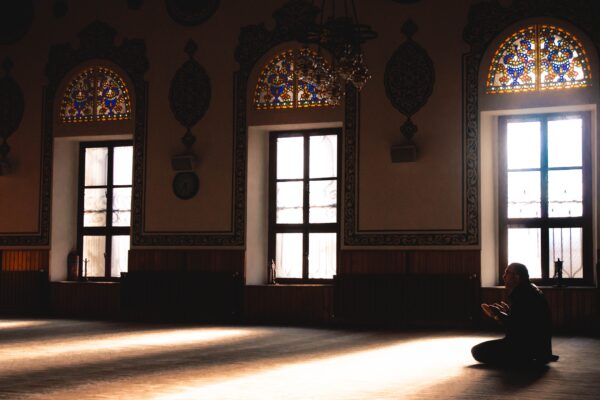In other Biblical scriptures there exists beautiful descriptions of the Prophet Muhammad (s), clearly distinguished from Jesus (a). Solomon, or Prophet Suleiman (a), has what appears to be a poetic recitation lauding the Prophet (s) in the book known as the Song of Song’s chapter 5 verses 10-15.
Friday Sermon: How do Bible verses distinguish the coming of the Prophets Jesus (a) and Muhammad (s)?
In other Biblical scriptures there exists beautiful descriptions of the Prophet Muhammad (s), clearly distinguished from Jesus (a). Solomon, or Prophet Suleiman (a), has what appears to be a poetic recitation lauding the Prophet (s) in the book known as the Song of Song’s chapter 5 verses 10-15.
In Part 1, we reviewed the Qur’anic verses which command Muslims to care for faith communities. Part 2 introduced how a community remembers its past figures, evolving with new information and social demands. In part 3 we reviewed how the compilation and transmission of the Gospels raise a plethora of questions about their authenticity. In Part 4, we looked at the famous verse of Deuteronomy 18:18 which describes the Prophet Muhammad (s) in similar terms to Prophet Moses (a), a receiver of Divine revelation and law.
In this last part, we will look at how Bible scriptures present the coming of the Prophet Muhammad (s), and ensures his heralding cannot be mixed with that of Christ by distinguishing between the two of them. This is particularly important when introducing Islam to Christians and as a means of explaining the message of the Prophet Muhammad (s).
The Qur’an sets out a series of verses to demonstrate that the heralding of the Prophet Muhammad (s) was well known to the Jews, especially those of Medina who had emigrated to the region in preparation of the event. For example:
“And when there came to them a Book from Allah confirming that which was with them – although before they used to pray for victory against those who disbelieved – but [then] when there came to them (the Prophet) that which they recognised, they disbelieved in it” (2:89).
Bible verses expressly present the Jewish community as knowing of the coming of a prophet, distinguished from Christ, and yet to come. This was to the extent that the scholars would travel to verify claimants and ask questions about both Christ and this other prophet yet to come. Here are two series of verses as examples:
1) John 1:20 speaks of the mission of John the Baptist, known as Prophet Yahya (a). As his preaching was of such prophetic eloquence and depth, Jewish priests were drawn to him and asked him if he was the Christ or the other prophet, to which he denied both. This means that he and they knew of Christ and of another prophet thereafter.
“19 And this was John’s testimony when the Jews of Jerusalem sent priests and Levites to ask him, ‘Who are you?’ ; 20 He did not refuse to confess, but openly declared, ‘I am not the Christ.’ ; 21 ‘Then who are you?’ they inquired. ‘Are you Elijah?’ He said, ‘I am not.’ ‘Are you the Prophet?’ He answered, ‘No.'” (Berean Study Bible translation)
Here, there is Prophet Elijah (Elyias), Christ, and another Prophet – the Prophet Muhammad (s).
2) John 7:40 demonstrates there being a debate over the identity of Jesus (a). Is he the Christ or the other Prophet yet to come?
“39 He was speaking about the Spirit, whom those who believed in Him were later to receive. For the Spirit had not yet been given, because Jesus had not yet been glorified ; 40 On hearing these words, some of the people said, ‘This is truly the Prophet.’; 41 Others declared, ‘This is the Christ.’ But still others asked, ‘How can the Christ come from Galilee?'”
In other Biblical scriptures there exists beautiful descriptions of the Prophet Muhammad (s), clearly distinguished from Jesus (a). Solomon, or Prophet Suleiman (a), has what appears to be a poetic recitation lauding the Prophet (s) in the book known as the Song of Song’s chapter 5 verses 10-15:
10 My beloved is red and white,
outstanding among ten thousand.
11 His head is purest gold;
his hair is wavy
and black as a raven.
12 His eyes are like doves
by the water streams,
washed in milk,
mounted like jewels.
13 His cheeks are like beds of spice
yielding perfume.
His lips are like lilies
dripping with myrrh.
14 His arms are rods of gold
set with topaz.
His body is like polished ivory
decorated with lapis lazuli.
15 His legs are pillars of marble
set on bases of pure gold.
His appearance is like Lebanon,
choice as its cedars.
16 His mouth is sweetness itself;
he is altogether lovely.
This is my beloved, this is my friend.
Extensive commentary is beyond capacity here, so we will focus on comparing just the first stanzas. What immediately stands out is the appellation of his beloved, which matches the most famous title of the Prophet as HabeebAllah, or the Beloved of Allah.
In the books of Ahadith, collections focused on the Prophet Muhammad’s (s) physical features and mannerisms are known as the Shamaa’il Muhammadiyyah, particularly the Sahih by at-Tirmidhi, one of the earliest and most authentic compilations. In here and many other places the Prophet (s) is described as having a red and white complexion and black hair. For example:
Imam ‘Ali (a) said, “He was not too tall, nor was he too short, he was of medium height amongst the nation. His hair was not short and curly, nor was it lank, it would hang down in waves. His face was not overly plump, nor was it fleshy, yet it was somewhat circular. His complexion was rosy white. His eyes were large and black, and his eyelashes were long.”
His coming with ten thousand men appears to be a reference to his conquest of Mecca as well.
Here we can see many descriptions of a forthcoming prophet other than Jesus (a). And given that Jesus (a) came and there exists a void in the Jewish and Christian explanations for whom this prophetic character is, when we see the example and miracles of the Prophet Muhammad (s), it gives us a degree of certainty that this is who was being referred to.
There are many, many others too. For further reading, refer to the works of Dr. Ali Ataie, Biblical scholar, and the books, Is Prophet Muhammad in the Bible by Anthony Mathew Jacob, The Lost Testament: What Christians Don’t Know by Syed Mahdi al-Modarresi, and The Gospel of St. Barnabas.





